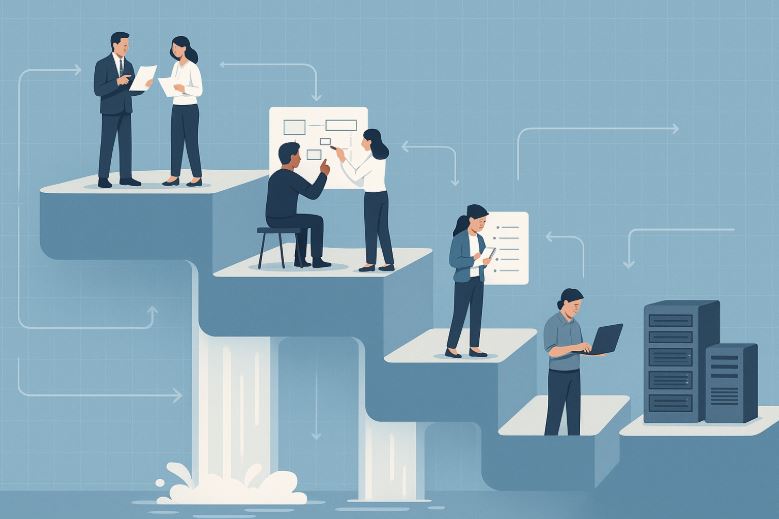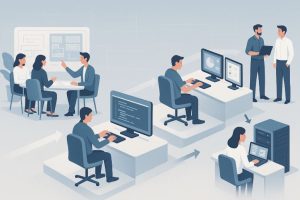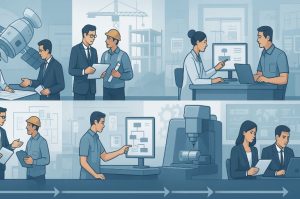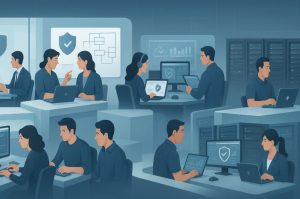
Why do organisations still rely on the waterfall methodology when agile, DevOps, and iterative models are dominating today’s development space? Is a structured, sequential approach still relevant in fast-paced technological environments?
The Waterfall software development model is a classic framework in the Software Development Life Cycle (SDLC) that has been used extensively for decades.
Despite the popularity of agile methodologies, the waterfall approach is still widely adopted in industries and projects that require rigorous planning, documentation, and precision.
Originating from early software engineering principles, the Waterfall model laid the foundation for modern development methodologies by introducing a logical and linear progression through development phases.
This model thrives in environments with fixed requirements, long-term planning, and limited scope for changes during execution.
In this comprehensive guide, we’ll examine what the waterfall model is, how it works, where it fits in the modern development ecosystem, and why it continues to be a critical part of software engineering history and practice.
What is the Waterfall Software Development Model?

The Waterfall model is a sequential and linear approach to software development. It divides the software project into distinct, pre-defined phases, and progress flows in one direction, like a waterfall. Each phase must be completed and reviewed before the next begins, with little or no overlap between phases.
The concept was introduced by Dr. Winston W. Royce in a 1970 paper, although the term “Waterfall” was not explicitly used. Royce’s focus on documentation and sequential development laid the groundwork for what we now refer to as the waterfall method.
This model became the first widely recognised SDLC framework, particularly suitable for large, structured projects where change is costly or undesirable after development begins.
Key Characteristics
- Linear process with defined start and end
- Distinct phases with rigid order
- Review the gates between each phase
- Heavy emphasis on documentation
- Minimal client involvement after initial requirements
How Does the Waterfall Model Work in Practice?

The Waterfall model works through a series of phases, each designed to achieve specific goals. Each phase produces deliverables used as inputs for the next, ensuring clear progression and accountability throughout the project.
Let’s explore each phase in depth.
1. Requirements Analysis and Specification
This initial phase involves gathering, analysing, and documenting all project requirements. The goal is to understand what the client or end user expects from the system.
These requirements are typically captured in a Software Requirements Specification (SRS) document, which serves as a formal agreement between stakeholders.
This stage also includes:
- Defining project scope and objectives
- Stakeholder identification
- Requirements validation
Once approved, the requirements become fixed and cannot be changed later without revisiting the entire cycle.
2. System and Software Design
With the requirements in place, the next phase focuses on system architecture and detailed design. This phase is split into two components:
| Design Stage | Description |
| High-Level Design (HLD) | Defines the architecture, major components, and data flow |
| Low-Level Design (LLD) | Focuses on individual modules, algorithms, data structures, and interfaces |
A Software Design Document (SDD) is produced to guide development and ensure consistency across teams.
3. Implementation (Coding)
This is where actual software development begins. Developers write code based on the design documentation. Typically, coding is done module-by-module, allowing for unit testing of each component to ensure functionality before integration.
During this phase:
- Programming languages and tools are selected
- Unit tests are conducted
- Code is reviewed for compliance with the design
4. Integration and System Testing
Once all modules are developed, they are integrated and tested as a complete system. The goal is to verify that the application behaves according to the SRS document.
Testing includes:
- Alpha testing (by developers)
- Beta testing (by selected users)
- Acceptance testing (by clients)
This phase ensures the system meets both functional and non-functional requirements, including performance, security, and usability.
5. Deployment
After successful testing, the system is deployed to a production environment. End-users are introduced to the software, often accompanied by training and documentation. This phase also involves setting up the required hardware, infrastructure, and backups.
6. Maintenance
Maintenance includes bug fixing, performance enhancements, and adapting the system to new environments. There are three types of maintenance activities:
| Maintenance Type | Purpose |
| Corrective | Fixing errors and bugs |
| Adaptive | Adjusting the software for new platforms or environments |
| Perfective | Enhancing performance or adding features based on user feedback |
This final phase can last for years, depending on the software’s lifecycle.
What Are the Advantages of Using the Waterfall Model?

Despite being a traditional model, Waterfall has several strengths:
- Clear structure: Phases are logically arranged, making the process easy to follow.
- Strong documentation: Each step is well-documented, aiding audits and future reference.
- Predictability: Fixed requirements mean predictable timelines and budgets.
- Easy project tracking: Progress can be measured by milestones and deliverables.
- Rigorous quality control: Testing and design reviews occur systematically.
This model is especially beneficial for teams that:
- Require high levels of control and discipline
- Have stable and well-defined project goals
- Are working on government or regulated projects
What Are the Limitations of the Waterfall Methodology?
The Waterfall model does not suit every type of project, especially those that are agile, fast-changing, or user-driven.
Some key limitations include:
- Inflexibility: Once a phase is completed, going back is difficult and costly.
- Late testing: Issues may not be found until the testing phase, making them harder to fix.
- Limited client feedback: Users are involved mainly at the start and end.
- Lengthy timelines: Sequential nature increases total project duration.
- Not adaptive to change: Scope changes disrupt the entire process.
When Should You Use the Waterfall Model?
The Waterfall model works best in scenarios with:
- Clearly defined and stable requirements
- Minimal expected changes during development
- Regulatory compliance needs (e.g., defence, healthcare, aviation)
- Long-term planning and budgeting constraints
- Projects where a working product is not needed until the end
It is ideal for small to medium-sized projects that benefit from strong documentation and rigorous controls.
Where Is the Waterfall Model Commonly Applied?

Waterfall is widely used in:
- Aerospace and defence projects
- Large IT infrastructure implementations
- Construction and civil engineering
- Manufacturing systems
- Legacy systems requiring maintenance
It also finds application in academic settings, where it is used as a teaching tool to introduce structured development approaches.
How Does Waterfall Compare to Agile and Other Models?
| Aspect | Waterfall | Agile |
| Process | Sequential | Iterative and incremental |
| Flexibility | Low | High |
| Documentation | Extensive | Light and flexible |
| Client Involvement | Limited | Ongoing |
| Testing | At the end | Continuous |
| Delivery | One-time release | Frequent updates |
| Cost of Changes | High | Low |
Agile is preferred in fast-paced, evolving projects. However, Waterfall remains strong in cases requiring high predictability and low tolerance for risk.
What Are Some Tools Used in Waterfall Project Management?
Popular tools that support the Waterfall methodology include:
| Tool | Purpose |
| Gantt Charts | Visualise project timelines and dependencies |
| Microsoft Project | Planning and resource allocation |
| Wrike | Task tracking with Waterfall-friendly features |
| TeamGantt | Drag-and-drop timeline management |
| IBM Rational | Requirements and design documentation |
These tools facilitate efficient planning, documentation, and milestone tracking.
Can You Provide a Real-World Example of the Waterfall Model?

- Requirements: Define features like fund transfer, transaction logs, and security protocols.
- Design: Architect databases, user interface, encryption systems, and access controls.
- Implementation: Develop components and conduct unit testing.
- Testing: Perform system-level testing, including security, performance, and beta testing.
- Deployment: Launch platform to public users and monitor in real-time environments.
- Maintenance: Release updates, add features like mobile support, and maintain security standards.
This structured approach is ideal when failure is not an option and the product must work flawlessly on first release.
Conclusion – Is Waterfall the Right Model for Your Next Project?
The Waterfall software development model remains a cornerstone of structured project planning. While modern development often favours flexibility and iteration, waterfall provides unmatched clarity, discipline, and control for projects with rigid scope and clear outcomes.
When deciding between Waterfall and other methodologies, consider:
- How fixed are the requirements?
- Can changes be accommodated mid-project?
- Is documentation a priority?
- Do regulatory or security standards require a formal approach?
For the right project, the Waterfall model can deliver predictable, high-quality results with reduced ambiguity and improved process control.
Frequently Asked Questions
What kind of projects are ideal for the Waterfall model?
Projects with fixed requirements, long timelines, and high regulatory or documentation demands are best suited for Waterfall.
How is risk managed in the Waterfall model?
By following a structured, documented process and conducting thorough reviews at each phase, risks are managed proactively.
Why is Waterfall not suitable for evolving projects?
The linear flow makes it difficult to incorporate changes once development starts, which is problematic for evolving scopes.
How does documentation help in Waterfall projects?
It ensures clarity, helps maintain consistency, and serves as a reference for future maintenance or audits.
Is there any overlap between phases in Waterfall?
No, each phase is completed fully before the next begins, which reduces flexibility but improves structure.
Can Waterfall be integrated with Agile?
Yes, many teams adopt a hybrid model where planning is done using Waterfall and development uses Agile sprints.
What’s the biggest benefit of using Waterfall over Agile?
Predictability. Waterfall provides a clear path from start to finish, making it ideal for projects with minimal scope changes.